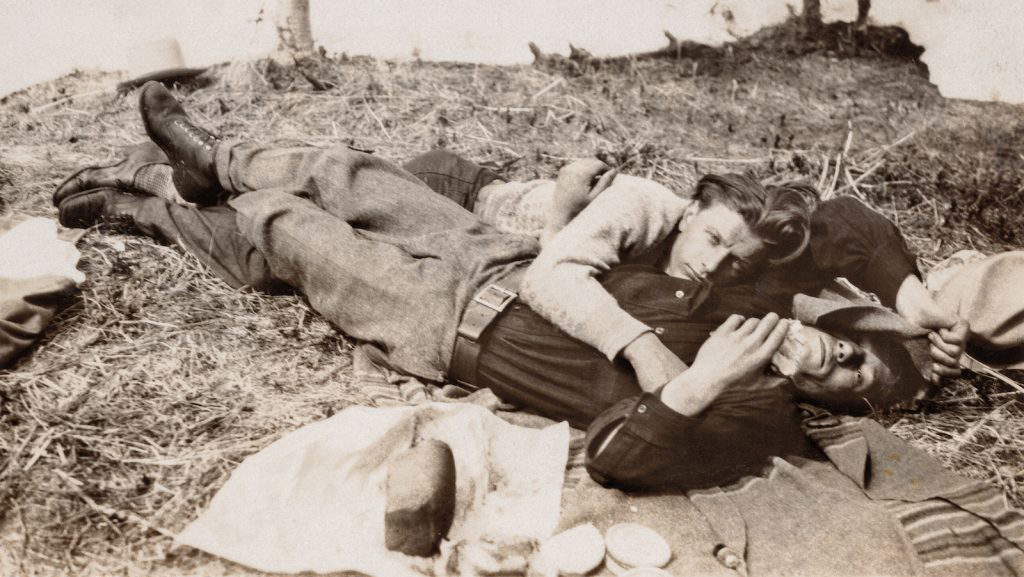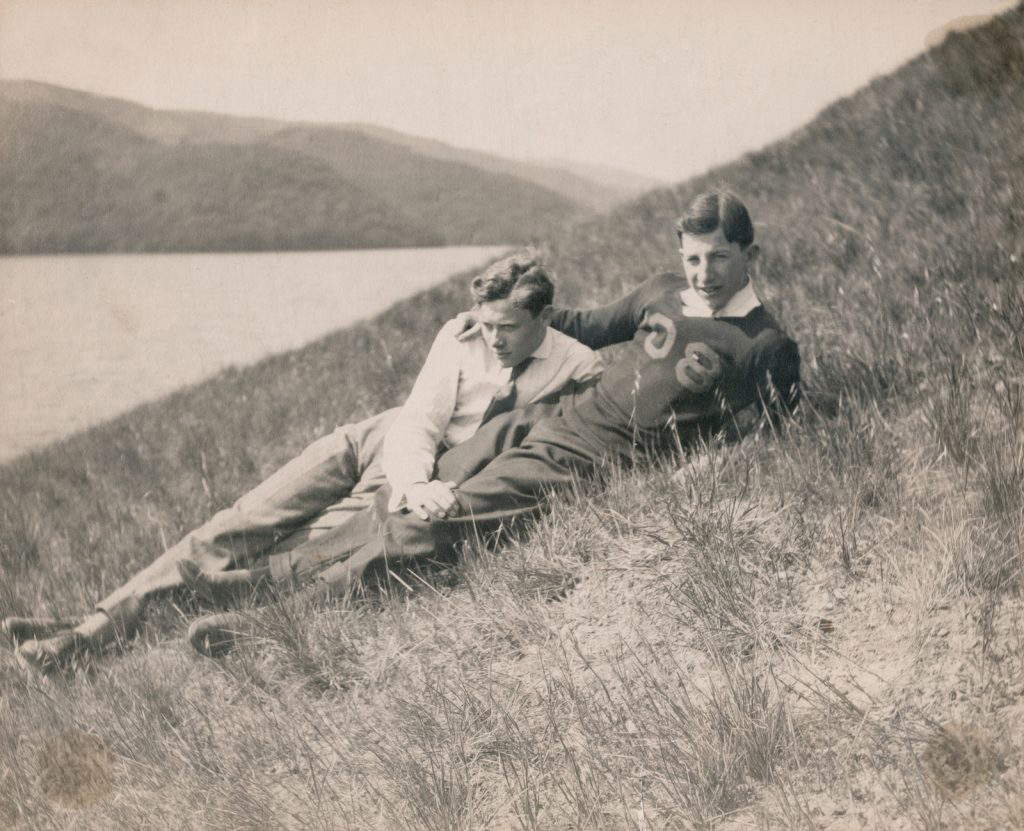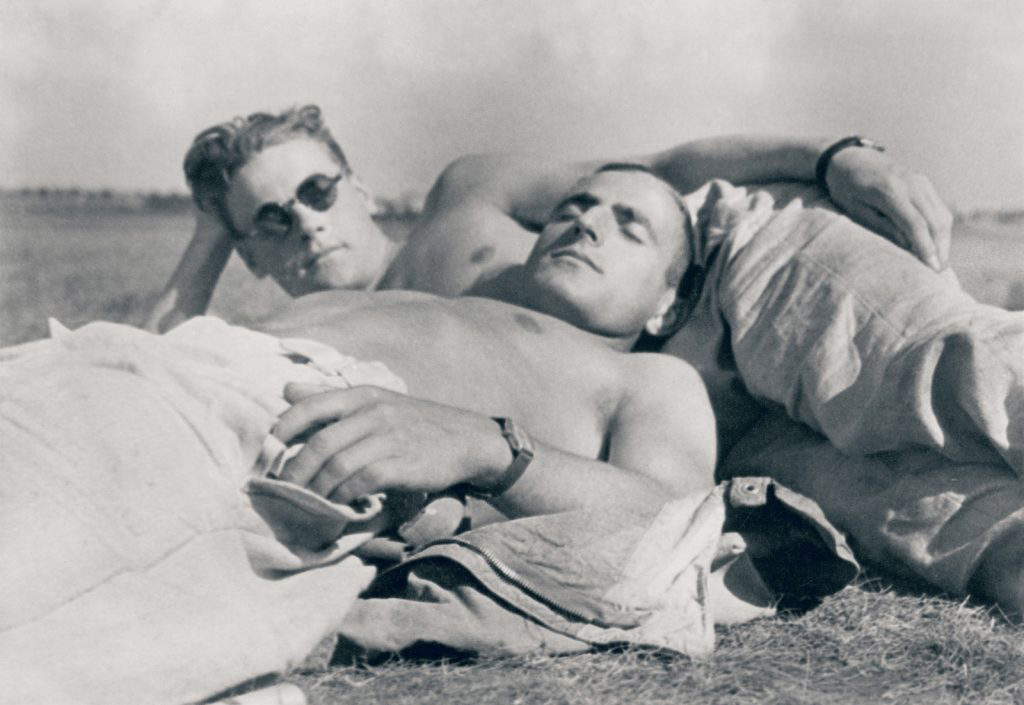For the first time anywhere in the world, the Musée Rath (Museum of Art and History) in Geneva is presenting an overview of Hugh Nini and Neal Treadwell’s exceptional collection of photographs of men in love. These photos, taken between 1850 and 1950, testify to periods and places where male love was and sometimes continues to be banned. After the publication of the photographic book Loving in 2020, which was an international success, the Texas collectors chose this time to present the shots in the eponymously titled exhibition scheduled through Sept. 24 in the halls of the Rath Museum, which will be complemented by a talk by artist Walter Pfeiffer and a screening of Urs Lüthi’s films.
By chance, while visiting an antique dealer in Dallas, Hugh Nini and Neal Treadwell stumble upon a 1920s snapshot lost in a pile of anonymous images. The photo depicts a young couple embracing and looking unmistakably in love. The collecting duo was then struck by the risk taken by the models posing in everyday clothes in the banal setting of an American suburb. Impressed by this image in which they recognize themselves, Ugo Nini and Neal Treadwell say they have found a treasure, the only tangible evidence of clandestine love. They are far from thinking that this is actually the beginning of a formidable search that will take them through flea markets between Europe, the Americas, Asia and Oceania, and online auctions. As their discoveries progress, this search for images “that speak to them” turns into a mission. Thanks to an appointment with a dealer specializing in antique photography in New York City, where the Texas-born couple settled in 2012, the idea of publishing the collection is born, and it finally takes shape in 2020, with the publication in 5 languages of the book Loving, to which the public reserves a great reception. From catalog to exhibition, the step is only one. In 2019, freshly appointed head of the MAH, Marc-Olivier Wahler meets with publishers about the upcoming work. Enthusiastic, he proposes to present this world premiere collection as part of an exhibition at the museum.
The Nini-Treadwell collection now numbers more than 4,000 images, covering the period 1850-1950 and coming from many countries around the world (the United States, the United Kingdom, Canada, France, Italy, Germany, Bulgaria, Croatia, Serbia, Hungary, Australia, Japan, Singapore, China, the Czech Republic, Slovakia, Estonia, Russia, Portugal, and South America). Aside from the images taken in the photo studios, the identity of the photographers is unknown; it could also be someone close to the couple, friend or family member, rather than a discreet and sympathetic professional, or even directly the people involved. The staging is identical to that adopted by heterosexual couples: the duos pose at the bow of a ship, on a tree branch, at the beach, in the forest, in bed, and may even launch into a mock wedding ceremony. All social classes and all ages are represented, from the factory worker to the entrepreneur, via the student, the soldier, and the sailor. And one aspect emerges, whatever the place, period or nationality of the models: the symmetry between the characters adopting the same pose. Over the years, Hugh Nini and Neal Treadwell’s eye has been honed by dint of deciphering the images offered to them; since the Civil War, social norms have more than evolved and the signs of affection between men with them. Thus, collectors obey the 50/50 rule they have imposed on themselves: their intimate belief that the image represents a couple in love stands at 50/50. To do so, they say they rely on the eyes of the models: the feelings are expressed there, despite all efforts to hide them. Other signs that Hugh Nini and Neal Treadwell ended up decoding include the umbrella under which the couple takes refuge, synonymous with protection, but also wedding rings, bracelets and other jewelry.
This collection testifies to a need that the democratization of photography has made possible: that of recording a forbidden union between two beings. These thousands of images trace a century of photography’s history, opening a window on a world very different from our own and re-enacting it, they testify to the social progress of recent decades in most countries of the world. As they reveal the different faces that male love can take, the Nini-Treadwell collection celebrates the universality of the expression of the feeling love, affection, attachment.
As a form of tribute to the work done by the Texas collectors, a poetic installation greets the public at the Rath entrance. On the face of it, the universe of the Nini-Treadwell collection has little in common with that of Walter Pfeiffer (Zurich, 1946), known for his photographic works starring male models of unbridled sexuality. Cultivating joyful irreverence, the MAH chose to invite the Zurich-based artist to give his unique take on the museum’s selected set of clichés of men whose love bond has nothing artificial about it. Pfeiffer set his sights on many of these images of couples, enlargements of which dress the walls in colors chosen, for the most part, by the artist.
In the main rooms, the public finds in a series of display cases the selection of 400 shots taken by Hugh Nini and Neal Treadwell from their extensive collection. There are perfectly posed portraits because they were taken in the studio, candid images (on the beach, in the mountains, etc.) or even photo sets. Because of their intimate nature, these original prints range from very small to medium size.
Complementing the presentation, two black-and-white videos by Urs Lüthi (Lucerne, 1947), from the collection of the Municipal Fund for Contemporary Art (FMAC), are to be discovered in the basement of the Rath in the form of a simultaneous projection. Produced at Art/Tapes/22 studios in 1974 during a stay by the Swiss artist in Florence, the two films use the split screen (sharing screen) process: Orgasm (7’45’’) shows, on the right side, an empty glass into which milk is gradually poured until it overflows, and, on the left, Lüthi’s face in the foreground enchaining the spasms caused by the drops of water running over his skin; Morir d’amore (7’) opposes on either side of the screen Lüthi, who plays face lighting from below using a flashlight, and Elke Kilga, the artist’s former partner, who calmly smokes before pointing a gun at the viewer. When he shoots, Lüthi collapses... In addition to the play of symmetry realized in the image and an intriguing allusion to the intimacy or hatred that can arise in a couple, this installation is also a nod to Lüthi’s performance that created discomfort among guests at an opening at MAH in 1975, The Artist is in the Basement.
All useful information on MAH website: Musée Rath
Musée Rath, Place de Neuve 1. 1204 Geneva Tel. +41 22 418 33 40/ Telefax +41 22 418 33 51

 Undated photograph, from the
Undated photograph, from the Undated photograph, from the
Undated photograph, from the Undated photograph, from the
Undated photograph, from the
 |
| An exhibition in Geneva chronicles men's love with historic photographs |
Warning: the translation into English of the original Italian article was created using automatic tools. We undertake to review all articles, but we do not guarantee the total absence of inaccuracies in the translation due to the program. You can find the original by clicking on the ITA button. If you find any mistake,please contact us.